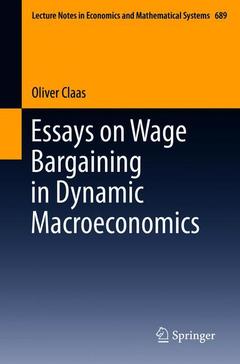Description
Essays on Wage Bargaining in Dynamic Macroeconomics, 1st ed. 2019
Lecture Notes in Economics and Mathematical Systems Series, Vol. 689
Author: Claas Oliver
Language: English
Subject for Essays on Wage Bargaining in Dynamic Macroeconomics:
Publication date: 11-2019
153 p. · 15.5x23.5 cm · Paperback
153 p. · 15.5x23.5 cm · Paperback
Description
/li>Contents
/li>Biography
/li>Comment
/li>
This book addresses collective bargaining in an intertemporal monetary macroeconomy of the aggregate supply?aggregate demand (AS?AD) type with overlapping generations of consumers and with a public sector. The results are presented in a unified framework with a commodity market that clears competitively. By analyzing the implications of three variants of collective bargaining ? efficient bargaining in a uniform and a segmented labor market and ?right-to-manage? wage bargaining ? it identifies the quantity of money, price expectations, union power, and union size as the determinants of temporary equilibria. In the three scenarios, it characterizes and compares the temporary equilibria using both analytical and numerical techniques, with an emphasis on allocations, welfare, and efficiency. It also discusses the dynamic evolution under rational expectations and its steady states in nominal and real terms. Lastly, it demonstrates conditions for stability regarding a balanced monetary expansion of the economy.
Introduction.- Efficient Bargaining in a Dynamic Macroeconomic Model.- Wage Bargaining, Employment, and Union Power: The Right-to-Manage Approach.- Efficient Bargaining Under Labor Market Segmentation in a Macroeconomic Model.
Oliver Claas is a researcher at Bielefeld University’s Center for Mathematical Economics (IMW). He holds a Ph.D. in Economic Theory from Bielefeld University, a Master of Science in Economics from Purdue University, and a Diplom (Master's equiv.) in Mathematical Economics from Bielefeld University. His research interests include macroeconomics, labor economics, and the theory of dynamical systems, using both analytical and numerical methods.
Embeds three variants of collective bargaining into a unified monetary macroeconomic framework
Provides full characterization of temporary equilibria under bargaining
Analyzes perfect-foresight dynamics in both nominal and real terms
Shows conditions for stability regarding a balanced monetary expansion
Uses analytical and numerical techniques
© 2024 LAVOISIER S.A.S.
These books may interest you

The New Collective Bargaining 52.70 €



